24 Wild Animals in Guyana [Wildlife in Guyana]
Want to know more about the wildlife in Guyana?
Discover 24 wild animals in Guyana in this post, as well as interesting facts about them. 🇬🇾
Learn All About Guyanese Animals
Ready to learn all about Guyanese animals?
I’ve always been fascinated by animals, and by how they can be so different from one country to another. In this guide, we’ll focus on the many animals Guyana has on the land, in the sky, and underwater.
I’ve split the guide into 4 categories:
- Native animals from Guyana
- Endangered animals of Guyana
- What is Guyana national animal?
- How many animals native to Guyana?
Let’s dive in right away with our first category!
Native Animals from Guyana
Guyana is a South African country located in the northern part of the continent, next to the Atlantic Ocean. It is one of the smallest countries in South America, and it is one of the least densely populated countries in the world, with about 743,000 inhabitants in a land of 214,000 km² / 833,000 sq mi. It is bordered by Venezuela, Suriname, and Brazil, and its capital and largest city is Georgetown, which counts more than 118,000 inhabitants.
An interesting part of the country that I wanted to tackle is its wildlife. In light of that, I have listed the best of it, and I hope you will love learning what animals live in Guyana.
Here’s the Guyana animals list.
1. Rockstone poison dart frog
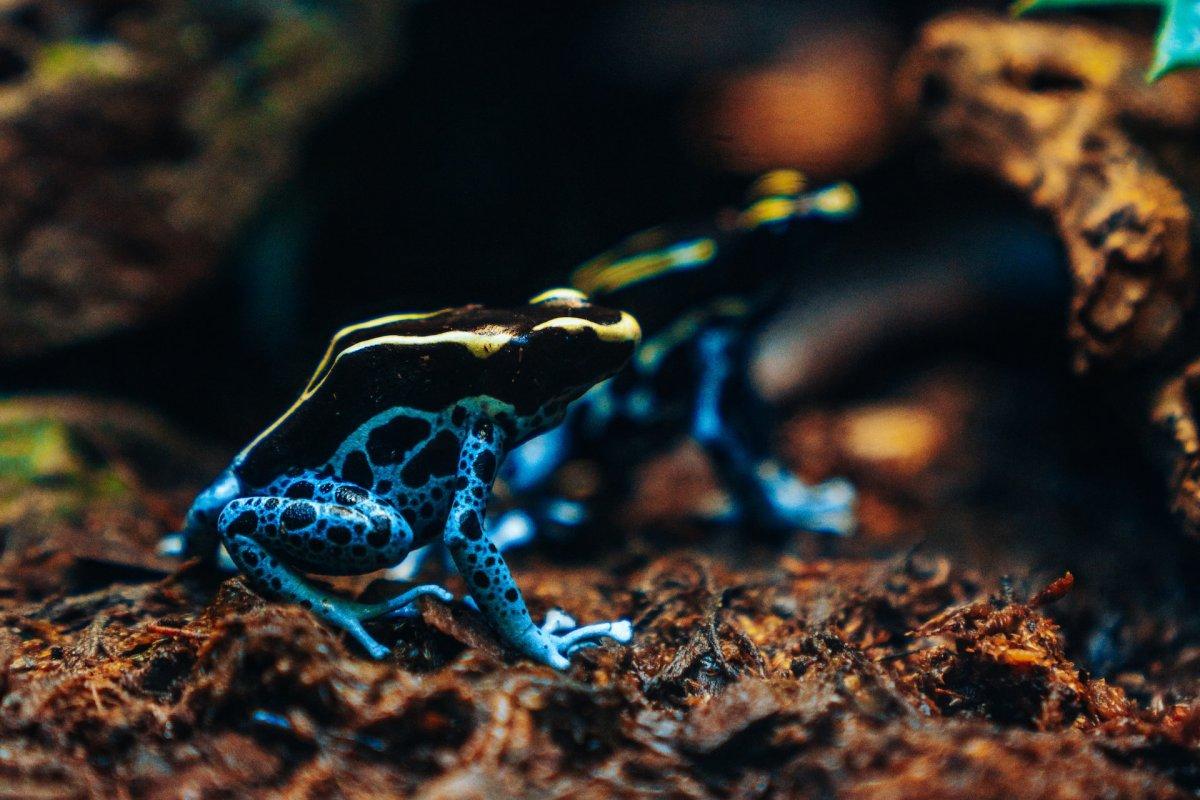
- Name: Rockstone poison dart frog
- Scientific name: Dendrobates nubeculosus
- Conservation status:
The rockstone poison dart frog is a species of frog endemic to Guyana. It is one of the least known species on the planet, as only one specimen was discovered, and it is smaller than other frogs of its genus.
The unique specimen, known as holotype, measures 2.5 cm / 1 ft, and its range is unknown. Primarily dark brown or black, it has blue splotches on the back. Nothing is known about its toxicity, social behavior, reproductive habits, or call.
2. Cane toad
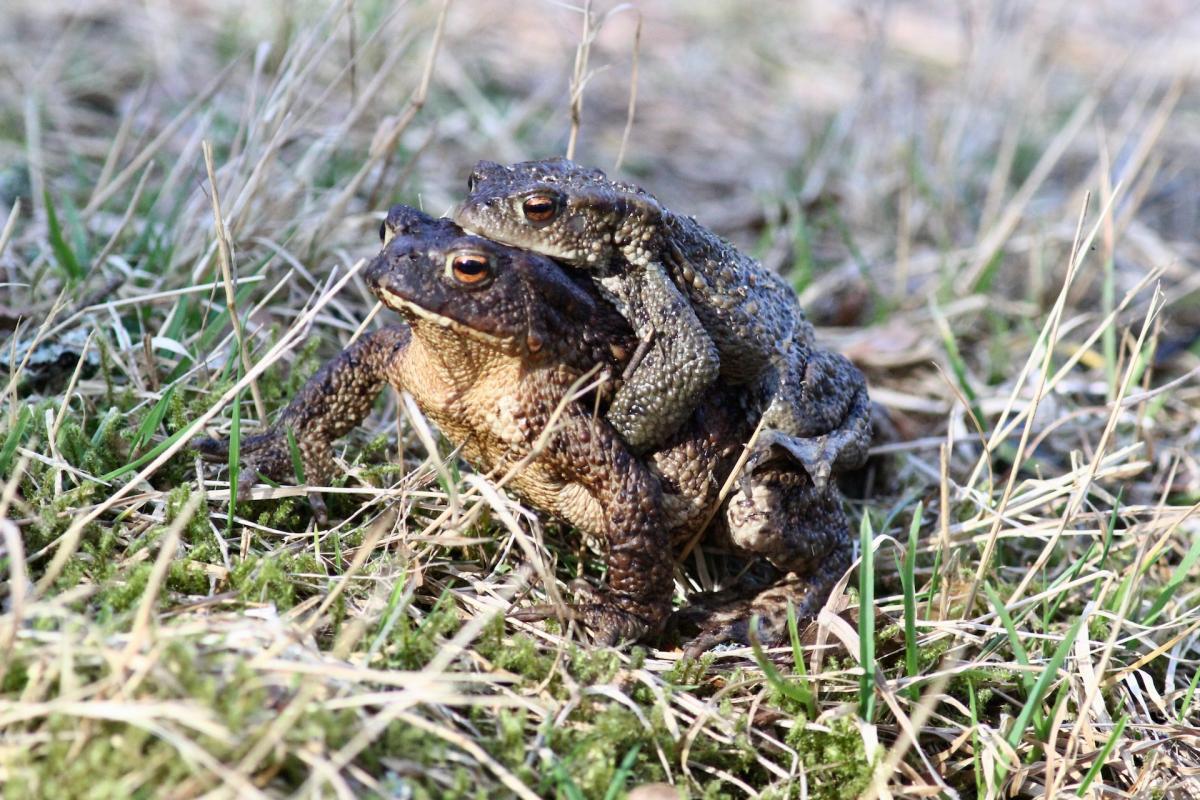
- Name: Cane toad
- Scientific name: Rhinella marina
- Conservation status:
As you may imagine, there are lots of species of amphibians in Guyana, and the cane toad, also known as the marine toad or the giant neotropical toad, is one of them. It is very large, and although native to South and Central America, it has also been introduced to some Caribbean Islands, as well as northern Australia.
Despite its lack of bright colors that are usually a warning, the cane toad has poison glands and is highly toxic if ingested.
3. Brown-banded water snake

- Name: Brown-banded water snake
- Scientific name: Helicops angulatus
- Conservation status:
The brown-banded water snake, also known as the water mapepire, is a species of aquatic snake native to Trinidad and Tobago and South and Central America. It lives in tropical waters, and it is venomous: not much is known about its interaction with humans, but it can rapidly kill mice.
This snake lives in brackish and freshwater and feeds on fish, frogs, eels, tadpoles, and lizards, as well as curious small mammals such as rodents.
4. Silky anteater
- Name: Silky anteater
- Scientific name: Cyclopes didactylus
- Conservation status:
The silky anteater, also known as the pygmy anteater is, as its names imply, a small species of hairy anteater native to Central and South America. It is the smallest of all anteaters and is both completely arboreal, which is quite unusual for such an animal, and nocturnal.
This species can move areas without needing to descend from trees. It is slow-moving and mostly feeds on ants, eating between 700 and 5,000… in a single day!
5. Giant armadillo
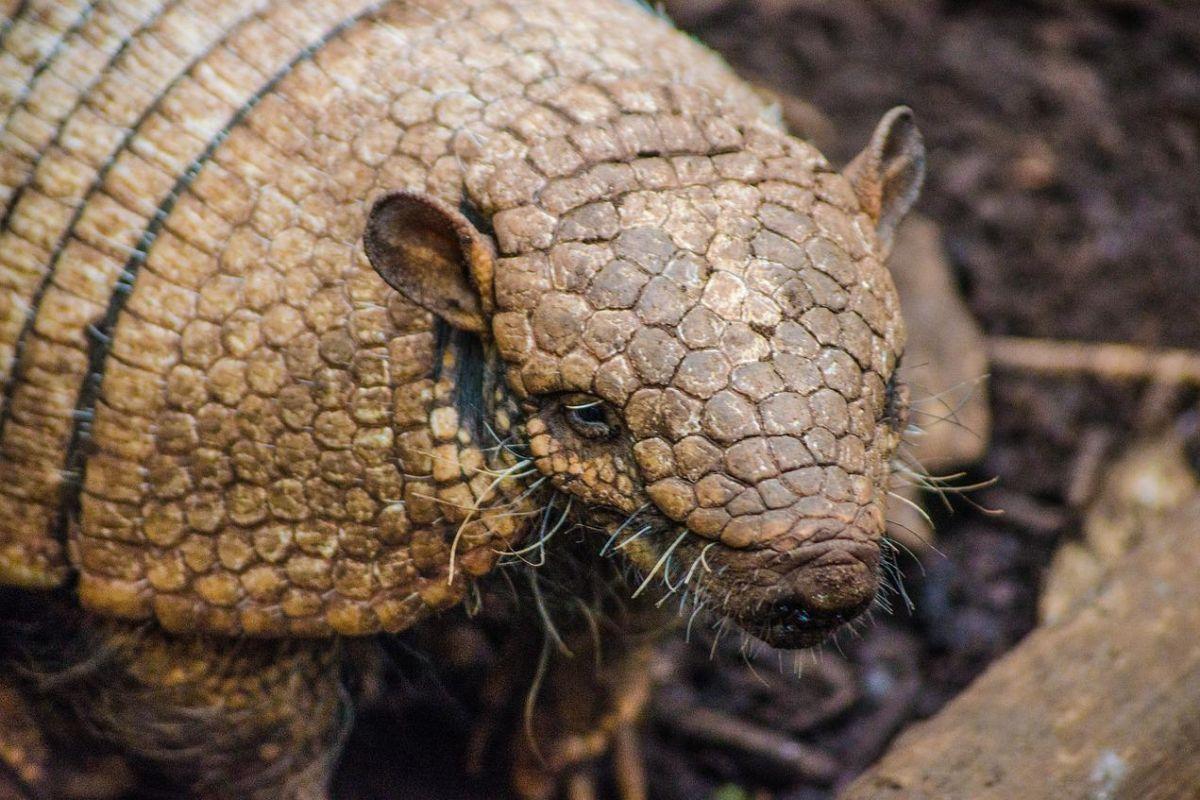
- Name: Giant armadillo
- Scientific name: Priodontes maximus
- Conservation status:
The giant armadillo, also known as the tatou, the ocarro or the tatú carreta, is the largest species of armadillo, hence its name. However, it used to have relatives, the glyptodonts, that were much, much larger.
This species is considered vulnerable, mostly because of hunting for meat, capture for trade and habitat loss due to deforestation. Its diet is largely made of ants and termites, and it often consumes the entire population of a single termite mound!
6. Jaguarundi
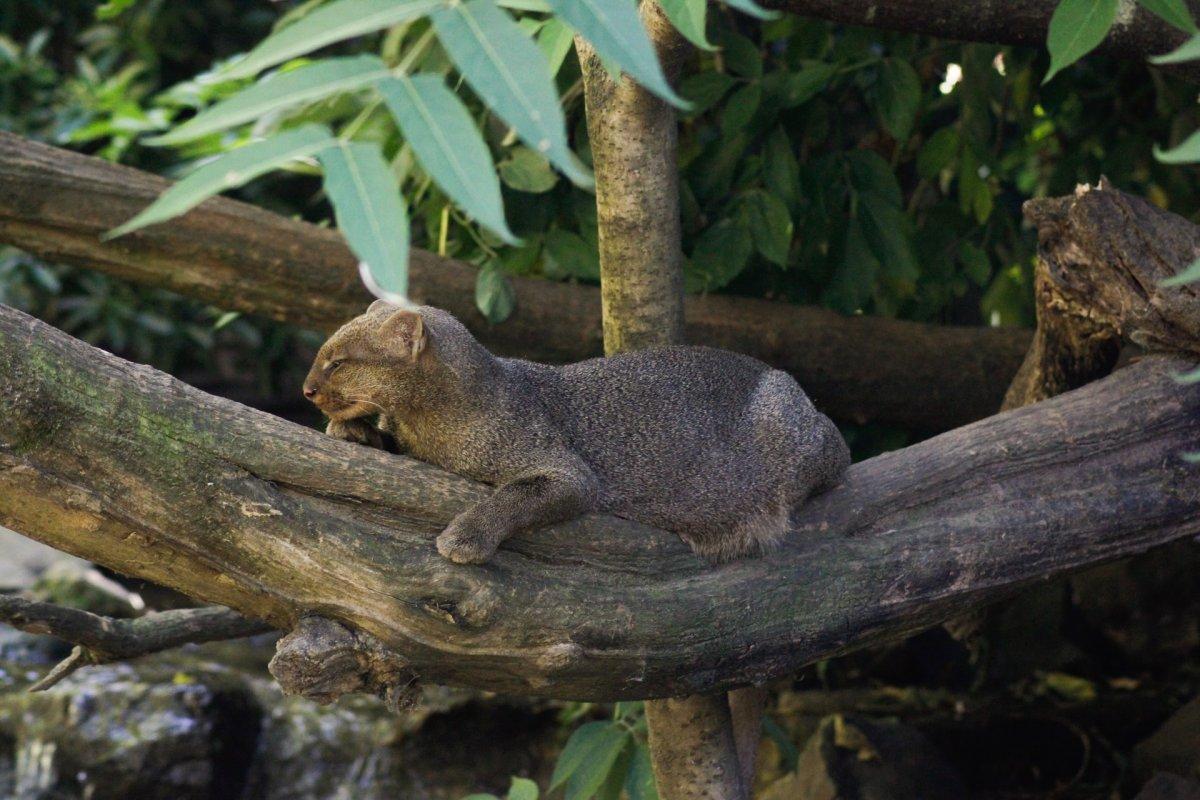
- Name: Jaguarundi
- Scientific name: Herpailurus yagouaroundi
- Conservation status:
The jaguarundi is a species of wild cat native to the Americas. It can be found from Central Argentina to northern Mexico, and it has a slender build with gray and red coat.
This animal is very alert and elusive and is therefore very hard to see. It is either solitary or forms pairs in the wild, but captive individuals are much more gregarious. Unlike most wild cats, it is active during the day and is an efficient climber that feeds on birds, reptiles and rodents.
7. Ocelot
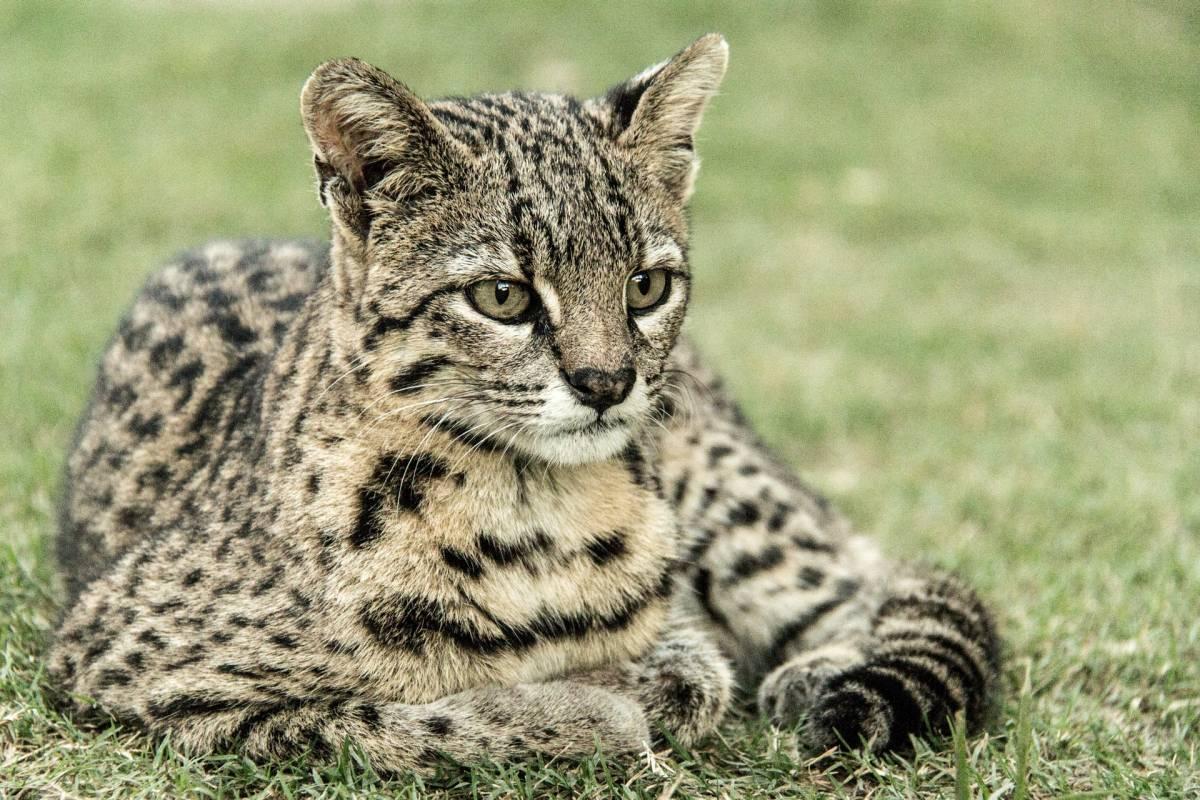
- Name: Ocelot
- Scientific name: Leopardus pardalis
- Conservation status:
Speaking of wild cats, there is the ocelot as well. This medium-sized spotted cat can be found from the southern United States to Central and South America, including some Caribbean Islands. It inhabits areas near bodies of water with a lot of prey and dense vegetation cover.
The ocelot is solitary and territorial, and is great at leaping, climbing, and swimming, making it a very efficient predator that feeds on small mammals, such as armadillos and opossums.
8. South American cougar
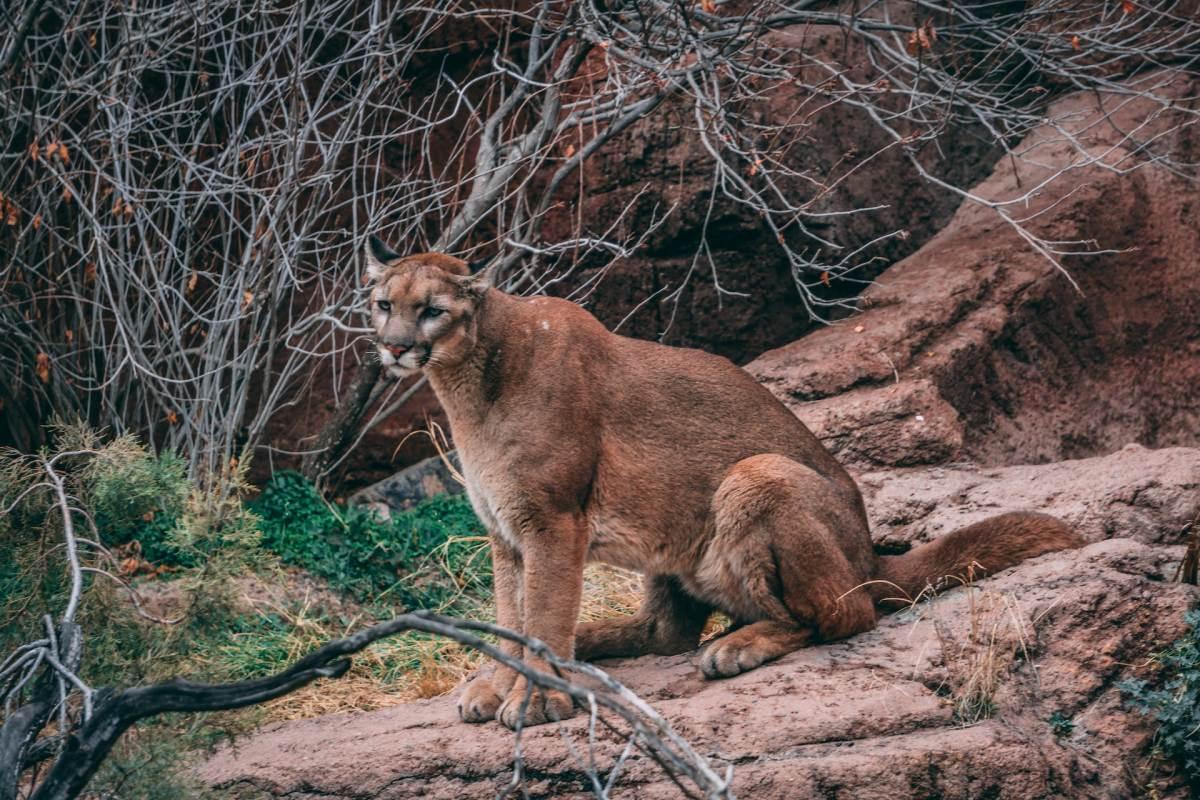
- Name: South American cougar
- Scientific name: Puma concolor concolor
- Conservation status:
The South American cougar is a subspecies of the cougar native to northern and western South America. It is also known as the puma or the Andean mountain lion, and it preys on a wide range of animals, from small birds and frogs to sloths, deers and camelids.
This animal has a particular spot in South American culture: it is either considered a helper of people in local folklore… or a snatcher of souls.
9. Guianan squirrel monkey
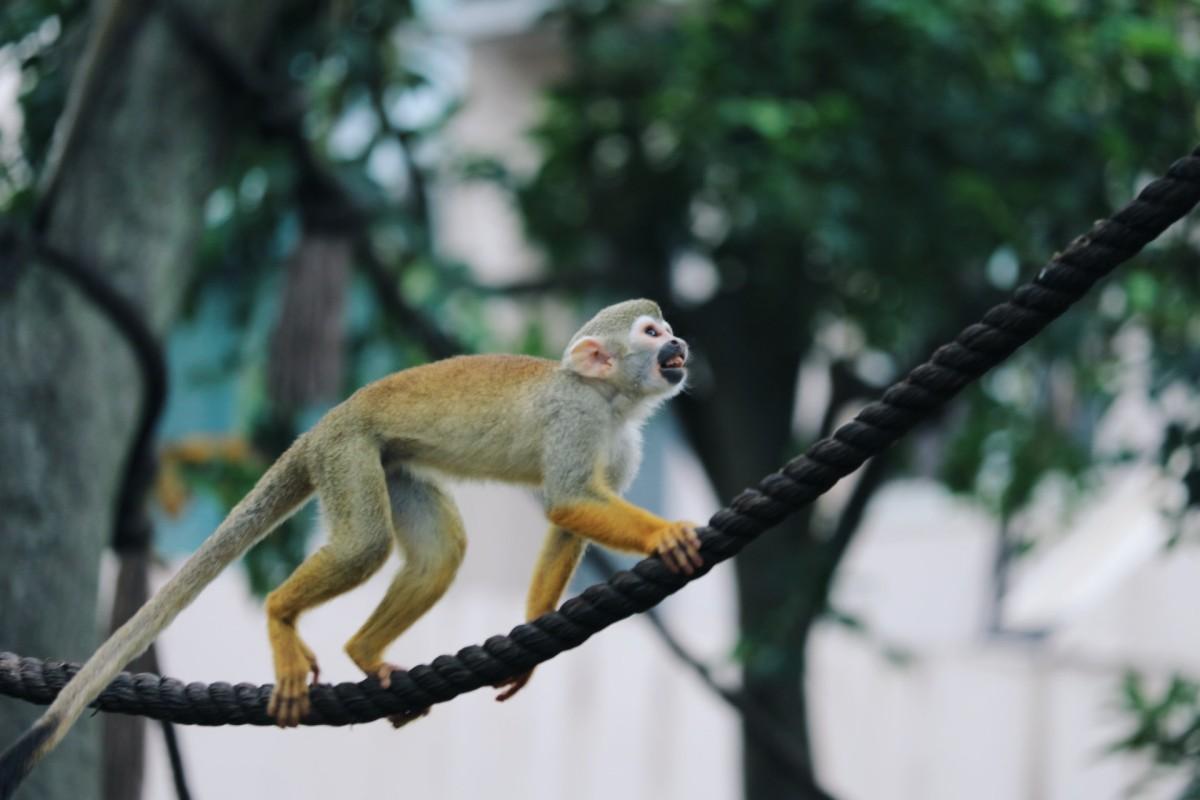
- Name: Guianan squirrel monkey
- Scientific name: Saimiri sciureus
- Conservation status:
How would it be possible to list the wildlife of a South American country without mentioning primates?
The Guianan squirrel monkey is a species of squirrel monkey native to the Guianas, not to be confused with Guyana. It tends to feed and move in mixed groups with capuchin monkeys, and some hybrids were already discovered. When the breeding season comes, males gain weight in the upper part of their body and become much more aggressive.
10. Spectral bat
- Name: Spectral bat
- Scientific name: Vampyrum spectrum
- Conservation status:
The spectral bat, also known as Linnaeus’s false vampire bat or the great false vampire bat, is a species of large bat native to Mexico, Central America, and South America.
Unlike most bats that are insectivorous and polygamous, it is a fierce, monogamous carnivore that feeds on rodents, birds, insects and other bats. It is the largest of all carnivorous bats and gets its name from its partly transparent, ghostly wings.
11. Red brocket
- Name: Red brocket
- Scientific name: Mazama americana
- Conservation status:
The red brocket is a species of deer native to South America, from Argentina to Colombia, as well as the island of Trinidad, after being extirpated from Tobago. Little is known about this species, except that it browses on vegetation, usually preferring fruit and seeds when available, but it was already seen eating fungi.
This animal is elusive and shy and stays hidden in dense forests. When alarmed, it snorts or stomps its hooves.
12. Leatherback sea turtle
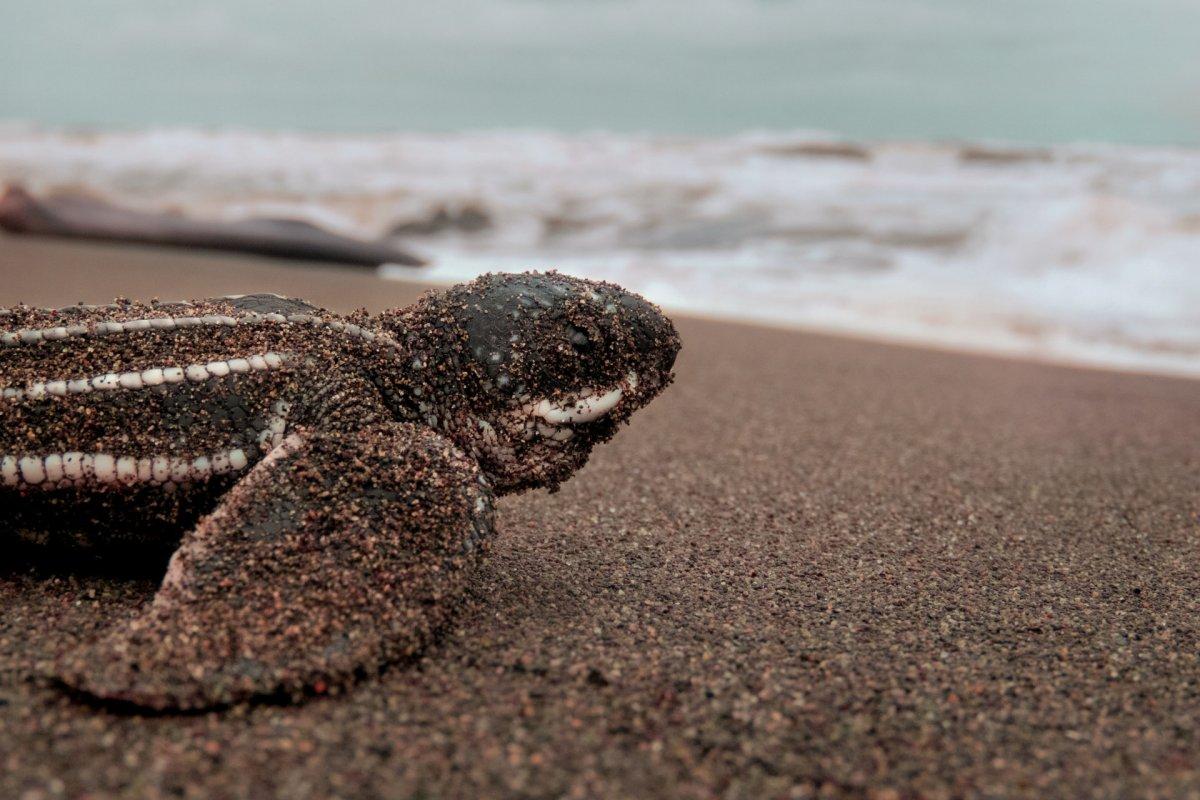
- Name: Leatherback sea turtle
- Scientific name: Dermochelys coriacea
- Conservation status:
Exceptional. Majestic. Unique. These are probably the best words to describe the leatherback sea turtle, an animal of all records. Also known as the luth, the lute turtle, or the leathery turtle, it is the largest turtle in the world and the largest non-crocodilian reptile. Reaching up to 2 m / 6.5 ft and 600 kg / 1,322 lb, it has unique, flexible skin, after which it is named; unlike other sea turtles, it doesn’t have a bony shell.
13. Daggernose shark
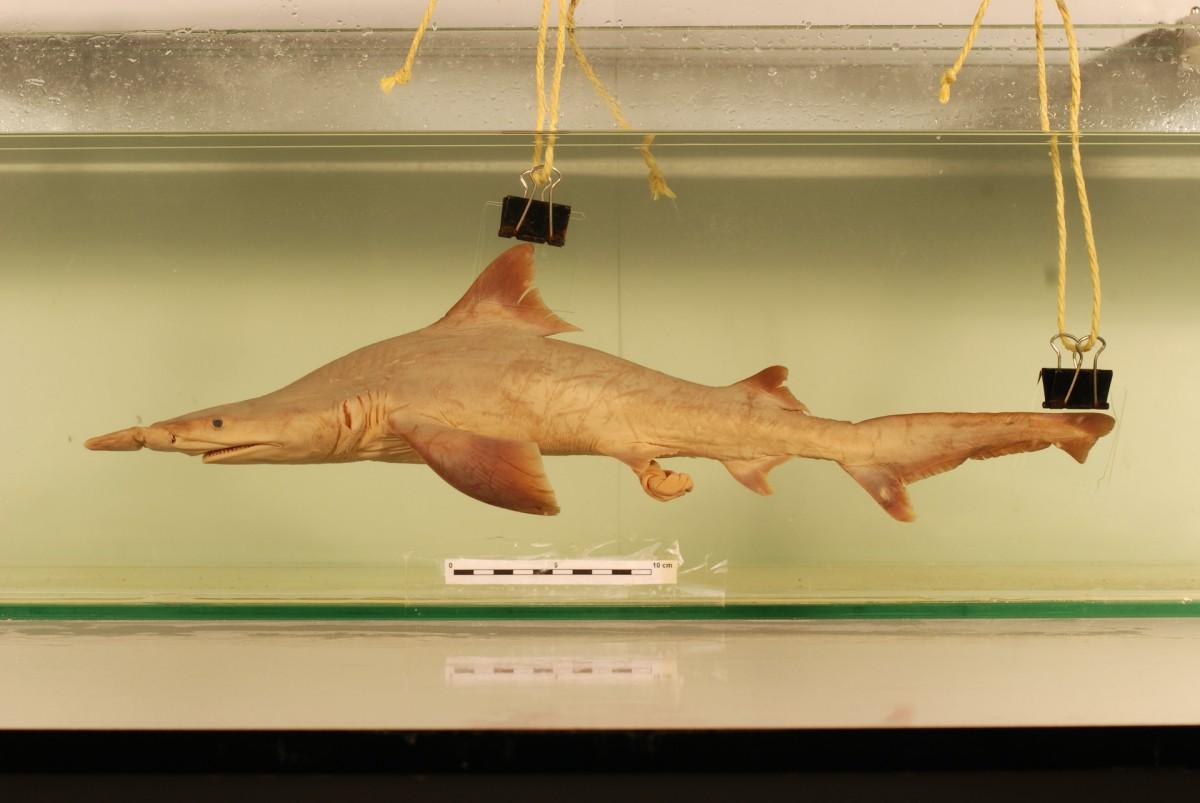
- Name: Daggernose shark
- Scientific name: Isogomphodon oxyrhynchus
- Conservation status:
The daggernose shark is a peculiar species of shark and a little-known one. It is part of the requiem sharks, and inhabits tropical waters off the coast of South America. It lives in muddy habitats such as river estuaries or mangrove swamps, though it is intolerant of freshwater.
Similar to other sharks, it is a predator of other fishes. Although harmless to humans, it is caught for food in artisanal and commercial fisheries and is critically endangered due to that and pollution.
14. Capybara
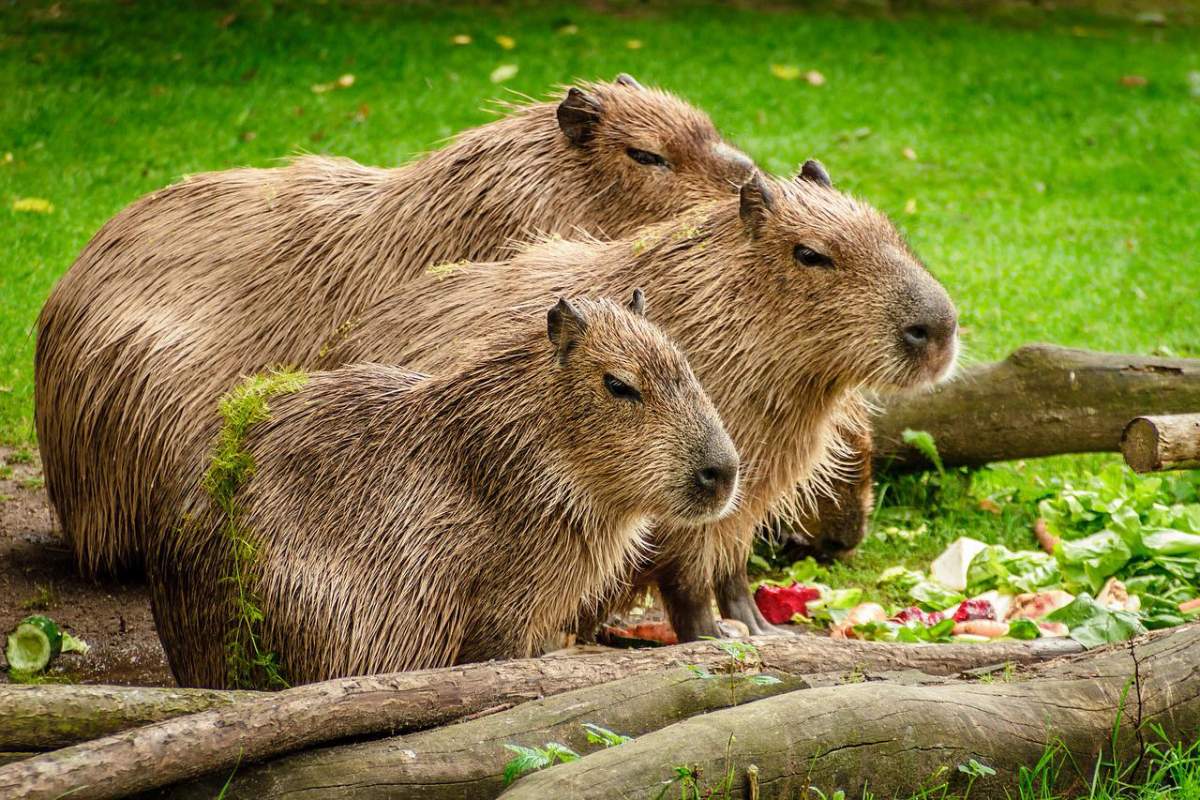
- Name: Capybara
- Scientific name: Hydrochoerus hydrochaeris
- Conservation status:
The capybara, also known as the greater capybara, is a giant species of rodent native to South America. It is the largest rodent in the world and is closely related to rock cavies and guinea pigs, and more distantly to agoutis, nutrias, and chinchillas.
Due to its very wide distribution and large numbers, this species is under no threat of extinction. It is largely hunted for its meat and hides, as well as its meat.
15. Crab-eating raccoon
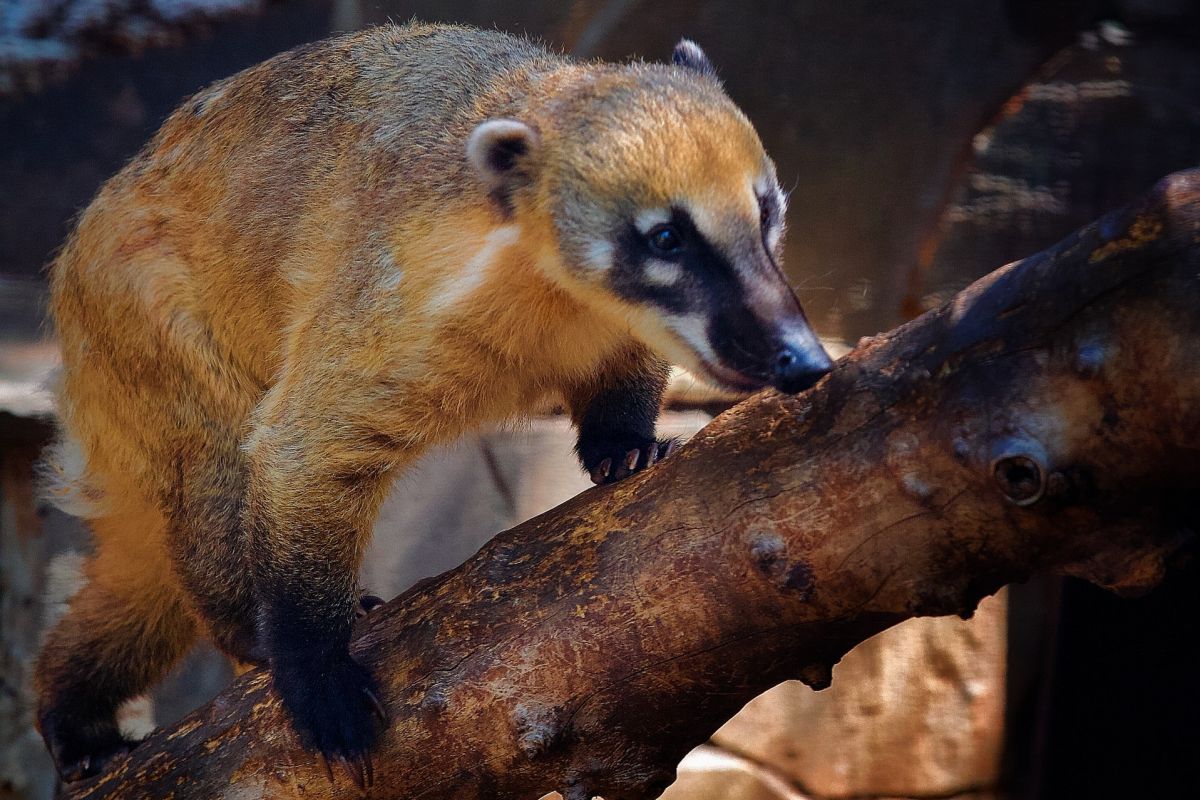
- Name: Crab-eating raccoon
- Scientific name: Procyon cancrivorus
- Conservation status:
The crab-eating raccoon, also known as the South American raccoon, is a species of raccoon native to Central and South America, as well as the islands of Trinidad and Tobago. Despite its name, it does not exclusively feed on crabs, although they represent a significant part of its diet: outside of them, this raccoon also eats shellfish, crayfish, and other crustaceans.
It is a solitary and nocturnal mammal that spends a significant part of its time in trees, though it is mostly terrestrial.
16. Wedge-capped capuchin
- Name: Wedge-capped capuchin
- Scientific name: Cebus olivaceus
- Conservation status:
The wedge-capped capuchin, also known as the Guianan weeper capuchin, is a species of capuchin monkey native to South America. It can be found in Guyana, Brazil, and Venezuela, and lives in tall forests, and does not hesitate to travel long distances during the day.
This monkey is a polygamous species that gathers in groups of about 5 to 30 members, with more females than males, where both sexes have their own hierarchical system.
17. White-faced saki
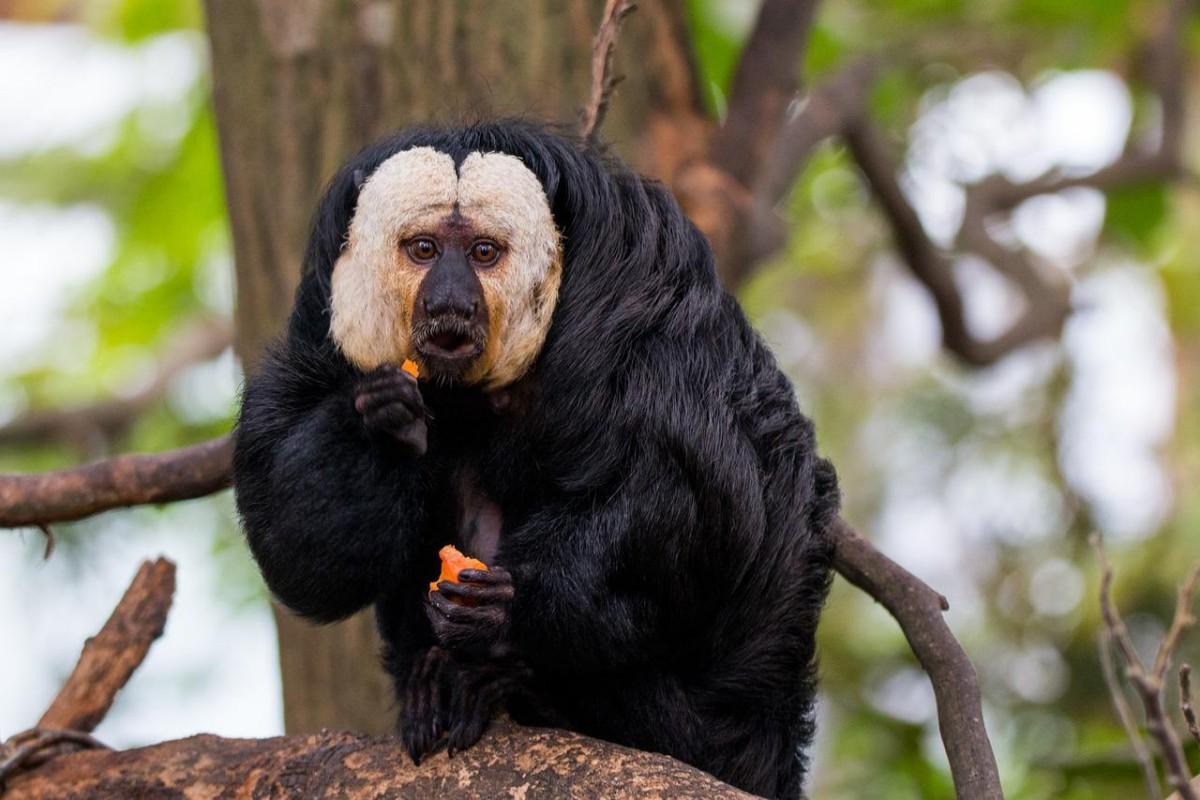
- Name: White-faced saki
- Scientific name: Pithecia pithecia
- Conservation status:
The white-faced saki, also known as the Guianan saki or the golden-faced saki, is a species of New World monkey native to French Guiana, Guyana and Venezuela. It inhabits the lower canopy of the forest and mostly feeds on fruit, seeds, insects and nuts.
This monkey is specialized in swinging from tree to tree, which is known as brachiation, and it lives about 14 years in the wild and up to 36 years in captivity!
18. Kinkajou
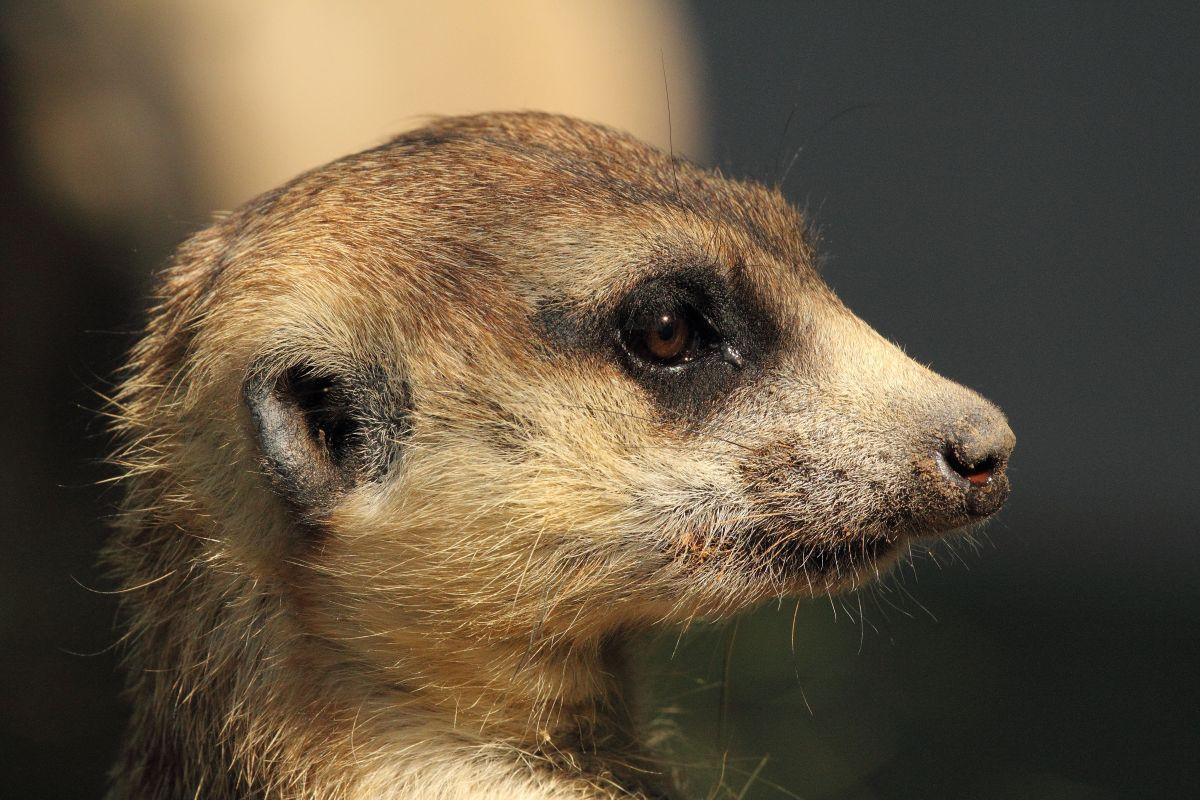
- Name: Kinkajou
- Scientific name: Potos flavus
- Conservation status:
The kinkajou is a species of tropical rainforest mammal native to Central and South America. It is mostly a frugivore and it is quite hard to spot as it is nocturnal and shy. It is related to raccoons, coatis and olingos, and it is sometimes called the honey bear.
This animal is not endangered, but it is hunted for the pet trade, its meat and its skin. It can live up to 40 years in captivity.
19. Brazilian porcupine
- Name: Brazilian porcupine
- Scientific name: Coendou prehensilis
- Conservation status:
You might have never heard of this animal, and yet the Brazilian porcupine is a fantastic creature. Outside of Brazil, it can also be found in Guyana, Argentina, Colombia, Peru and Paraguay, among other countries.
The reason for it to be so unique is its incredibly long prehensile tail that allows it to have an arboreal lifestyle. It is very gentle and was already tamed enough in captivity.
20. Tayra
- Name: Tayra
- Scientific name: Eira barbara
- Conservation status:
The tayra is a species of omnivorous weasel native to the Americas. It has a long, slender body and definitely looks like a marten or a weasel. This animal can be found throughout most of South America, and it inhabits tropical and subtropical forests, but also around croplands and plantations.
This weasel is diurnal, but can occasionally be active in the evening or at night. Although it is supposedly solitary, it was already seen in larger groups. Besides, it is an opportunistic carnivore that hunts for rodents, birds, and lizards.
21. Southern tamandua
- Name: Southern tamandua
- Scientific name: Tamandua tetradactyla
- Conservation status:
The southern tamandua, also known as the lesser anteater or the collared anteater, is a species of anteater native to South America and the island of Trinidad in the Caribbean Sea. It is a solitary animal that inhabits a wide range of habitats, from arid savannas to highly disturbed forests.
As its name suggests, it mostly feeds on ants, but also bees and termites. Because of its particularly strong foreclaws, it can be a dangerous enemy when cornered.
22. Giant otter
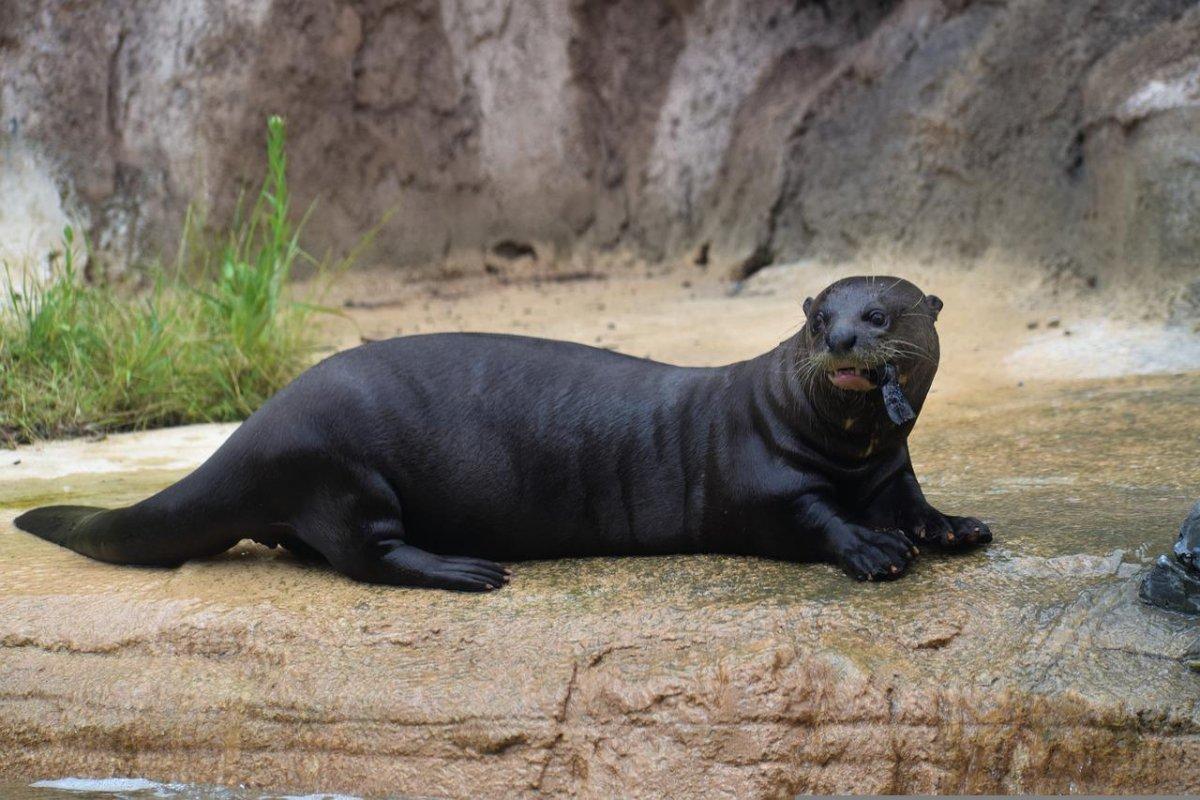
- Name: Giant otter
- Scientific name: Pteronura brasiliensis
- Conservation status:
The giant otter, also known as the giant river otter, is a species of carnivorous mammal endemic to South America. It is the longest member of the weasel family, as it can reach up to 1.7 m / 5.6 ft.
This otter is known for being the noisiest otter species, and it has distinctive vocalizations depending on the situation. It is an exclusive diurnal animal with a more and more reduced distribution, and serious threats such as poaching, pollution, and habitat fragmentation.
23. Lowland paca
- Name: Lowland paca
- Scientific name: Cuniculus paca
- Conservation status:
The lowland paca, also known as the spotted paca, and many other local names, is a species of large rodent native to tropical and subtropical South America. It was also introduced to Cuba and Algeria, and it has coarse fur without underfur.
This rodent is nocturnal, solitary and quite silent, and it lives in forests near bodies of water, ideally small rivers. It digs simple burrows or uses those of other animals, and it is a great swimmer.
24. Oncilla
- Name: Oncilla
- Scientific name: Leopardus tigrinus
- Conservation status:
The oncilla, also known as the little spotted cat, the tigrillo, or the northern tiger cat, is a species of small wild cat native to Central and South America. It largely resembles the margay, but is smaller, with a slender build.
This wild cat has thick, soft fur and many dark rosettes across its body, and is a terrestrial animal that has no problem climbing. It is an obligate carnivore that hunts small mammals, birds, eggs, invertebrates, and lizards, among others.
—
So there you have them, these were my 24 Guyana wild animals. I hope you enjoyed this list and that you learned something new today.
In case you want to learn more about animals in the country, feel free to keep reading, as I still have lots of things to tell you about:
Endangered Animals of Guyana
This is definitely the saddest part of the list, but it is very important to raise awareness. Because of this, let’s go through the list of endangered animals in Guyana.
Here are the animals in danger of extinction in Guyana.
- None
- Largetooth sawfish
- Wingfin stingray
- Daggernose shark
- Smalleye round ray
- Rio Branco antbird
- and 8 more…
- Giant otter
- Spinetail devil ray
- Caribbean reef shark
- Whale shark
- Sun parakeet
- and 35 more…
To see the full list of endangered species in Guyana, head over to the International Union for Conservation of Nature’s Red List.
What is the National Animal of Guyana?
The national animal of Guyana is the jaguar.
Guyana is not the only country that chose the jaguar as its national symbol, and it is in fact probably the most emblematic species in all of South America.
The jaguar is the third largest cat species in the world, and the largest one native to the Americas. Its ancestors came into the continent via the land bridge that used to go across the Bering Strait, between northeastern Russia and Alaska.
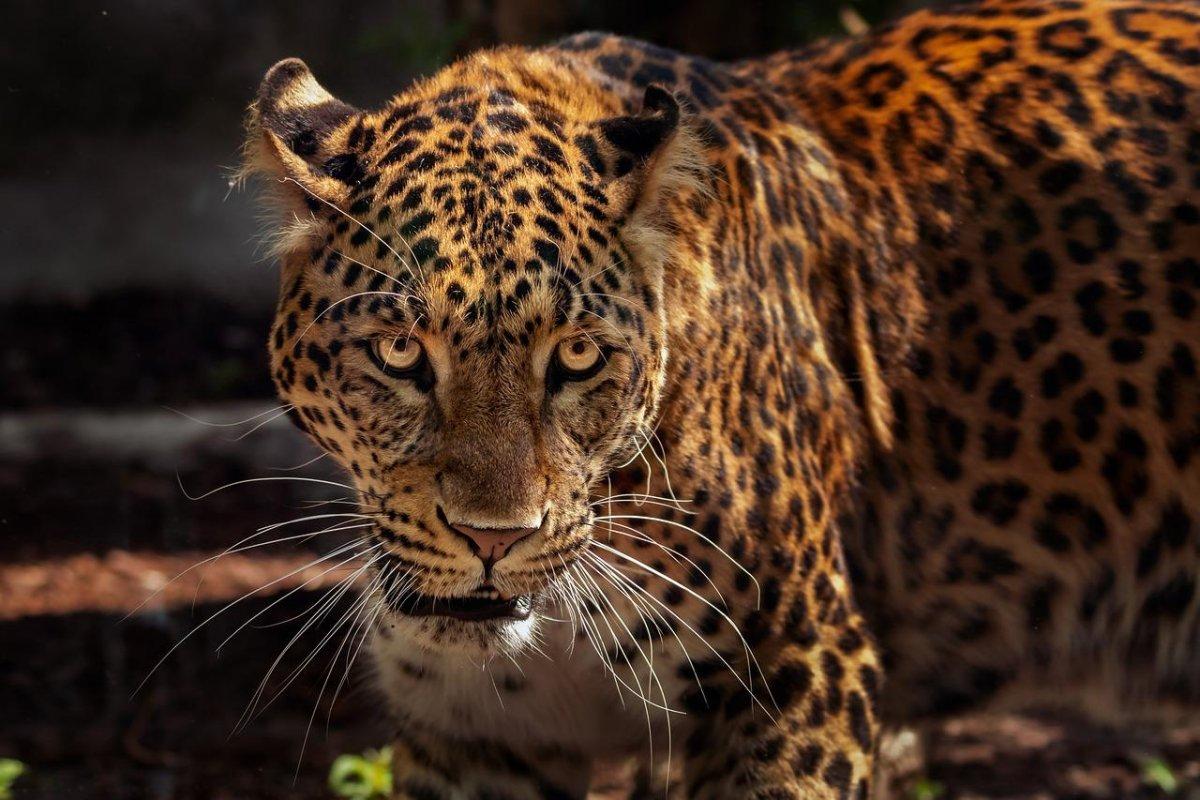
How Many Animals Native to Guyana?
What is the diversity of native animals in Guyana?
Let’s look at the total number of species of Chordata (mammals, birds, fishes, and reptiles).
Total number of animal species in Guyana: 2,509 (14,422 in total in South America)
More About Animals in the World!
Loved these Guyana wildlife facts? Want to see what animals live in other countries?
Then check out these posts:
Or click here to see ALL the facts up on the blog! Spoiler alert: there’s A LOT of them.
Share the knowledge! Click on the buttons below to share information about these famous animals found in Guyana with your friends, and help them learn more about the world 🙂
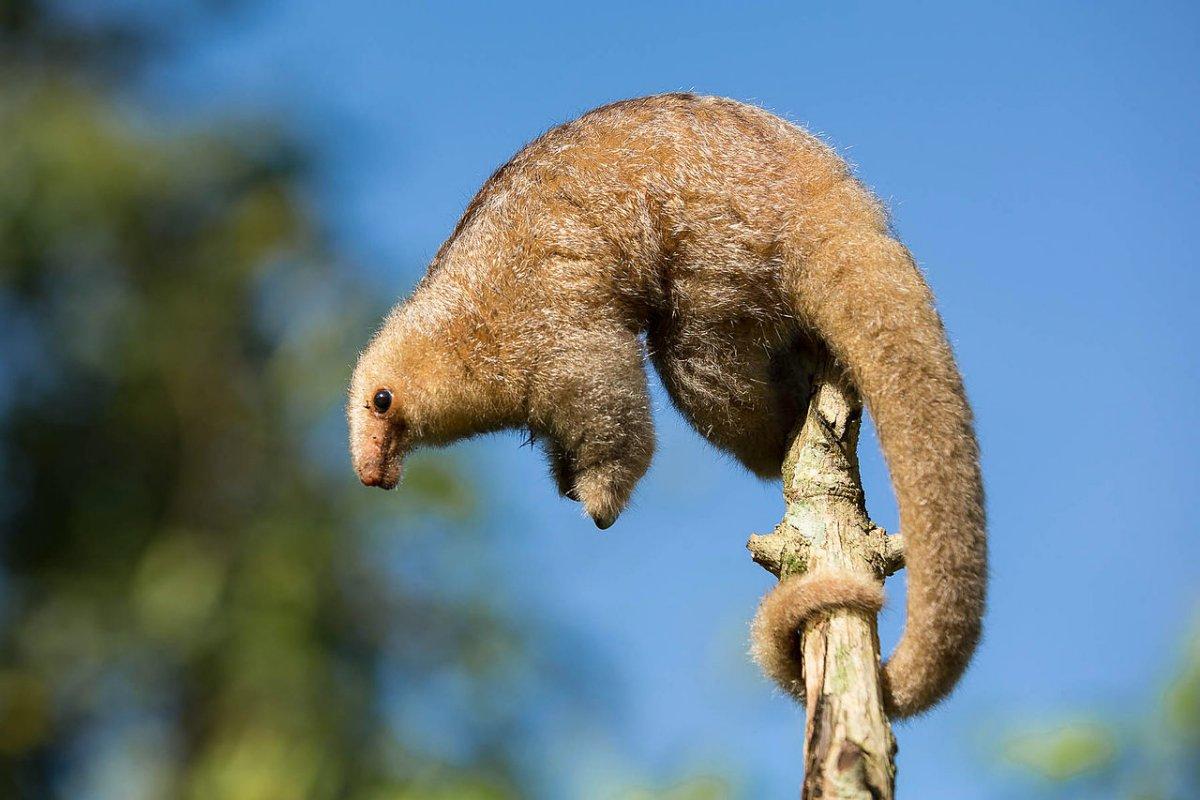
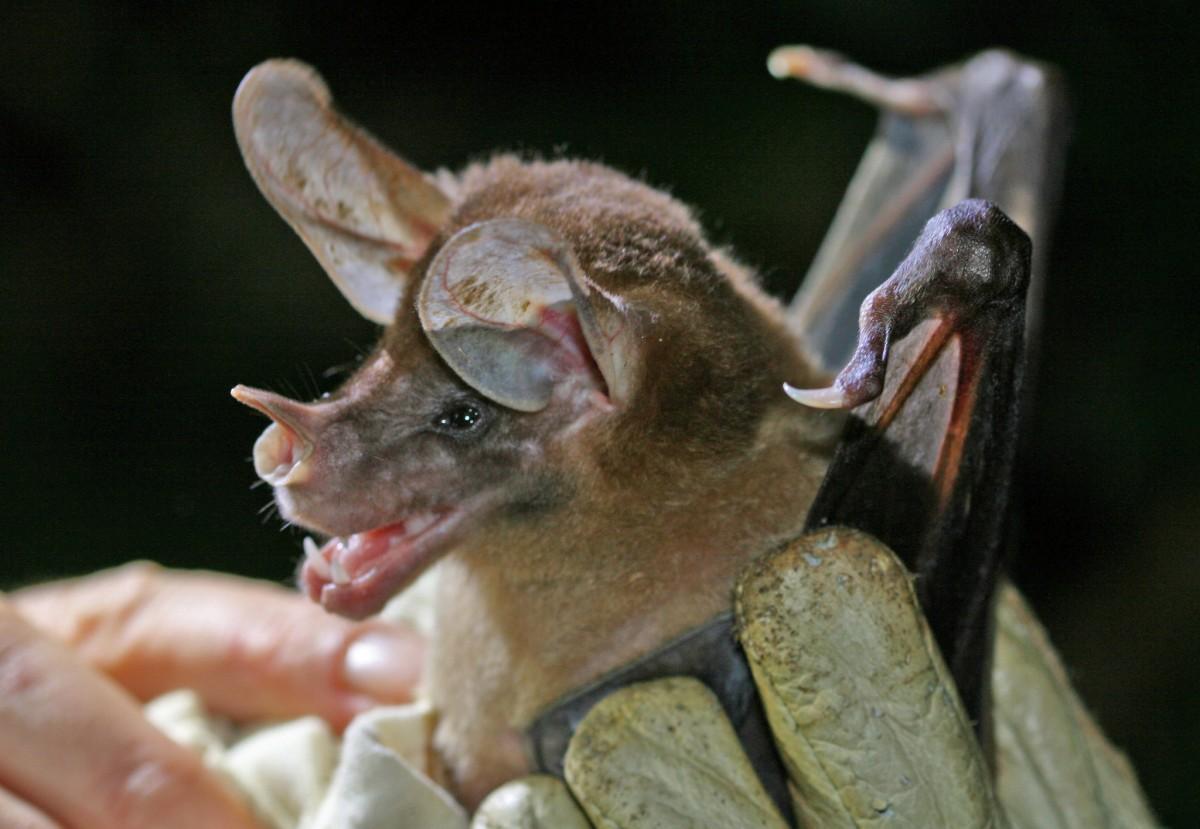
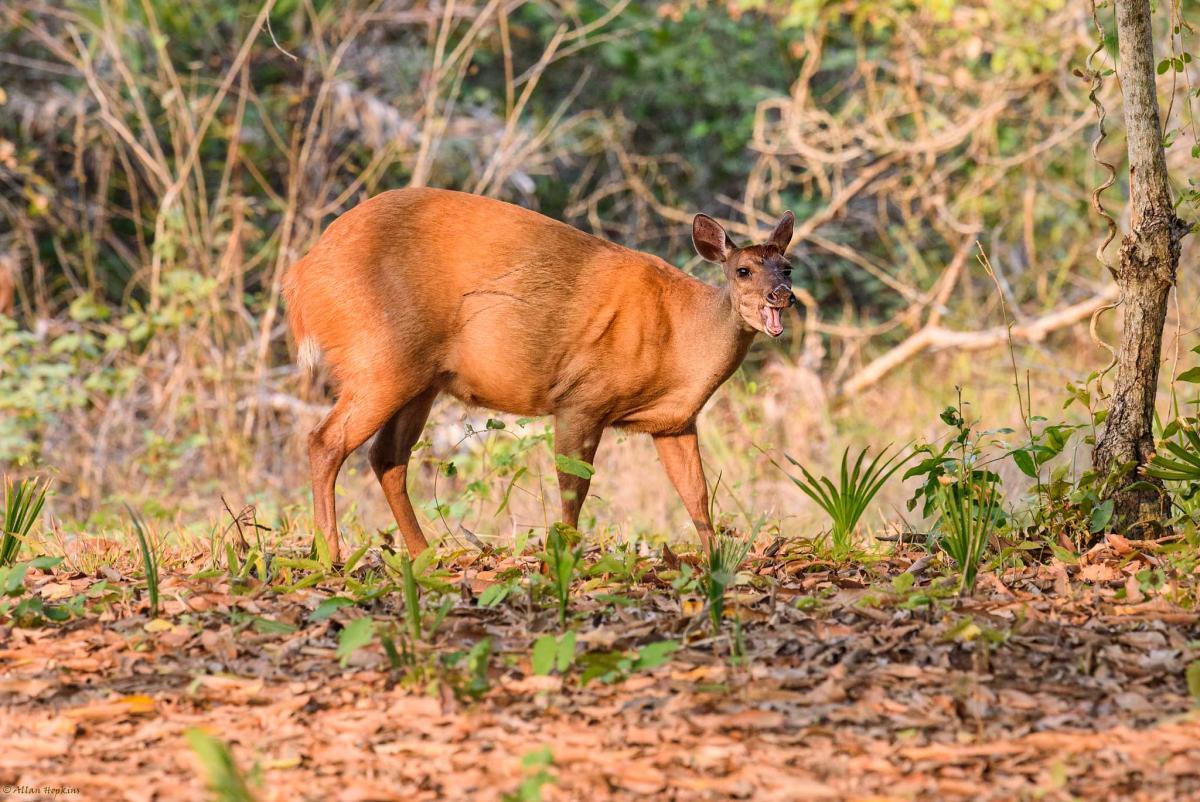
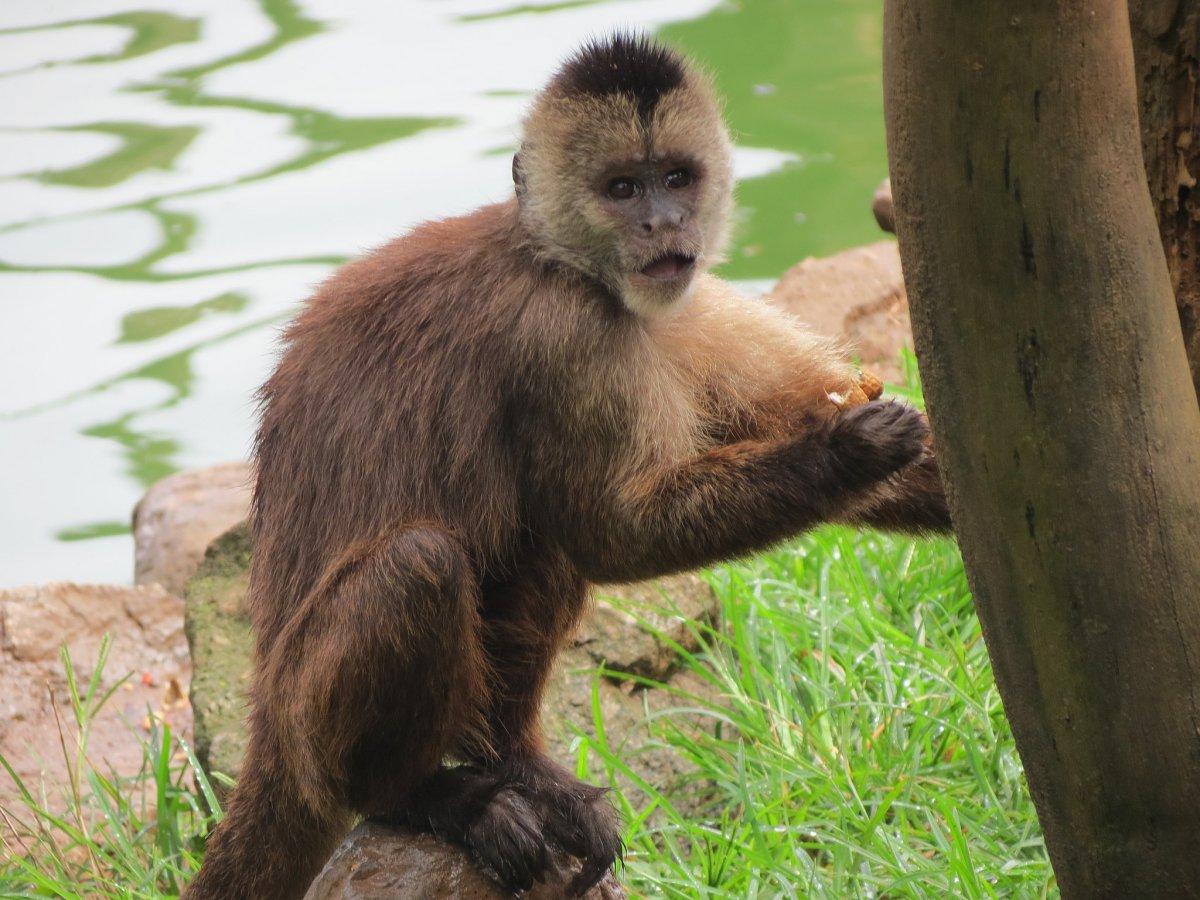
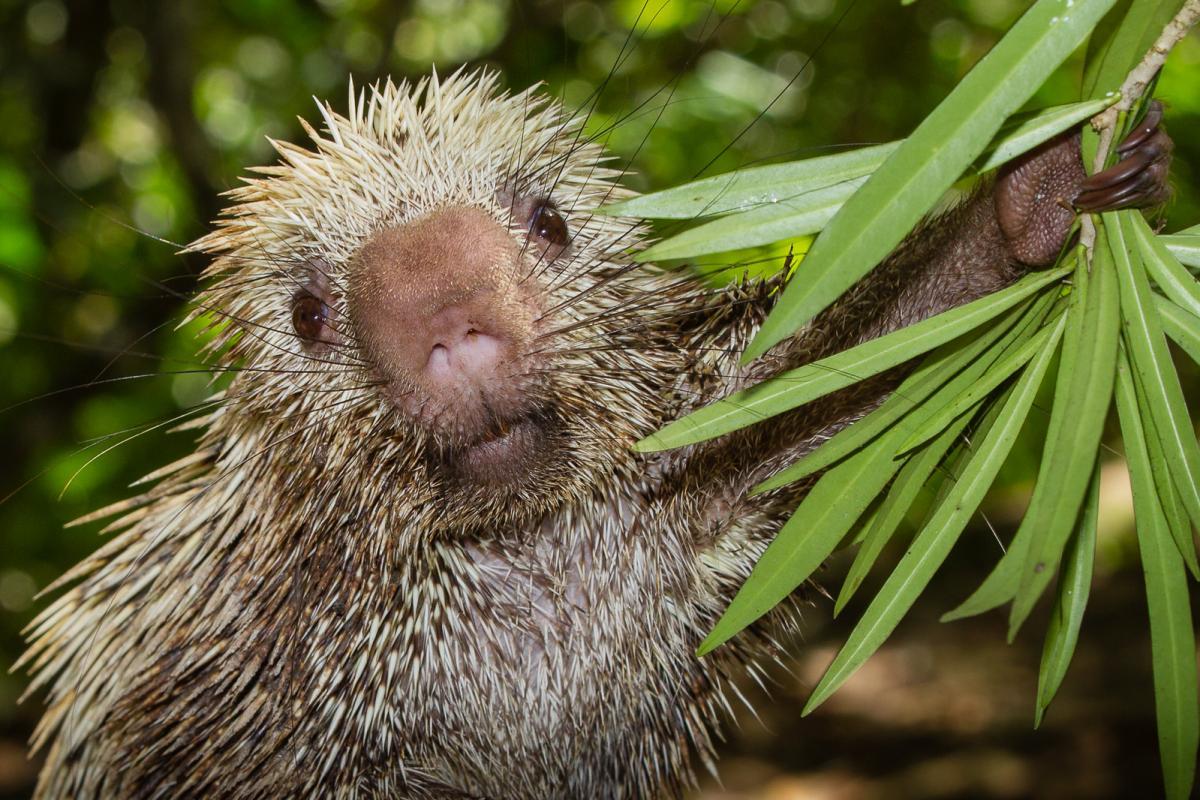
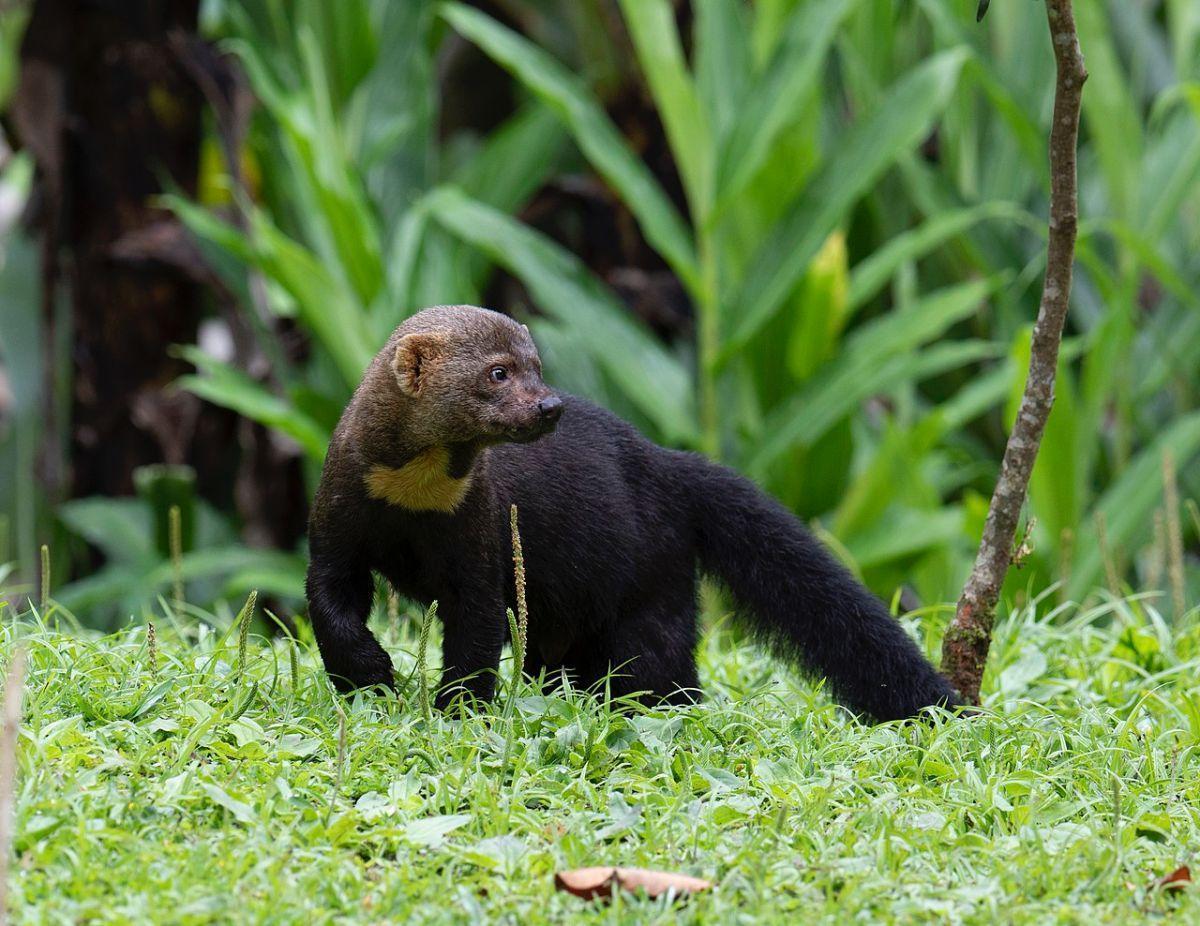
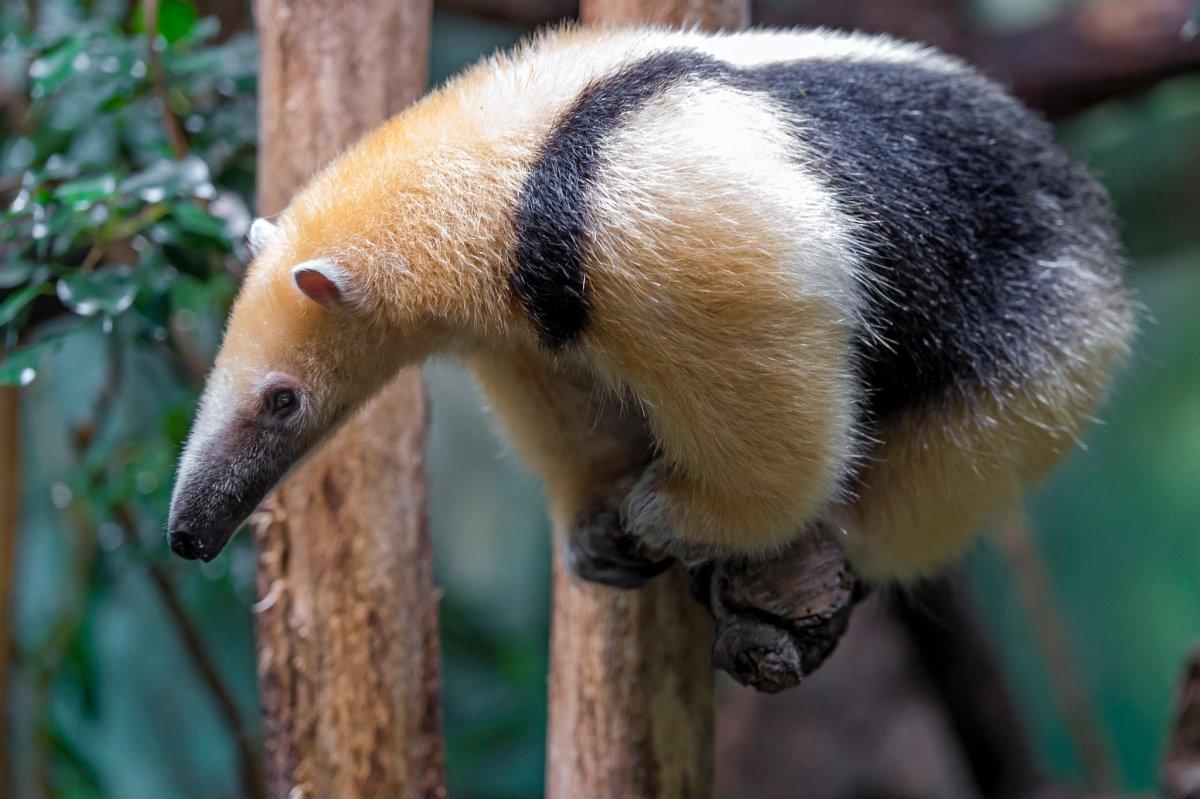
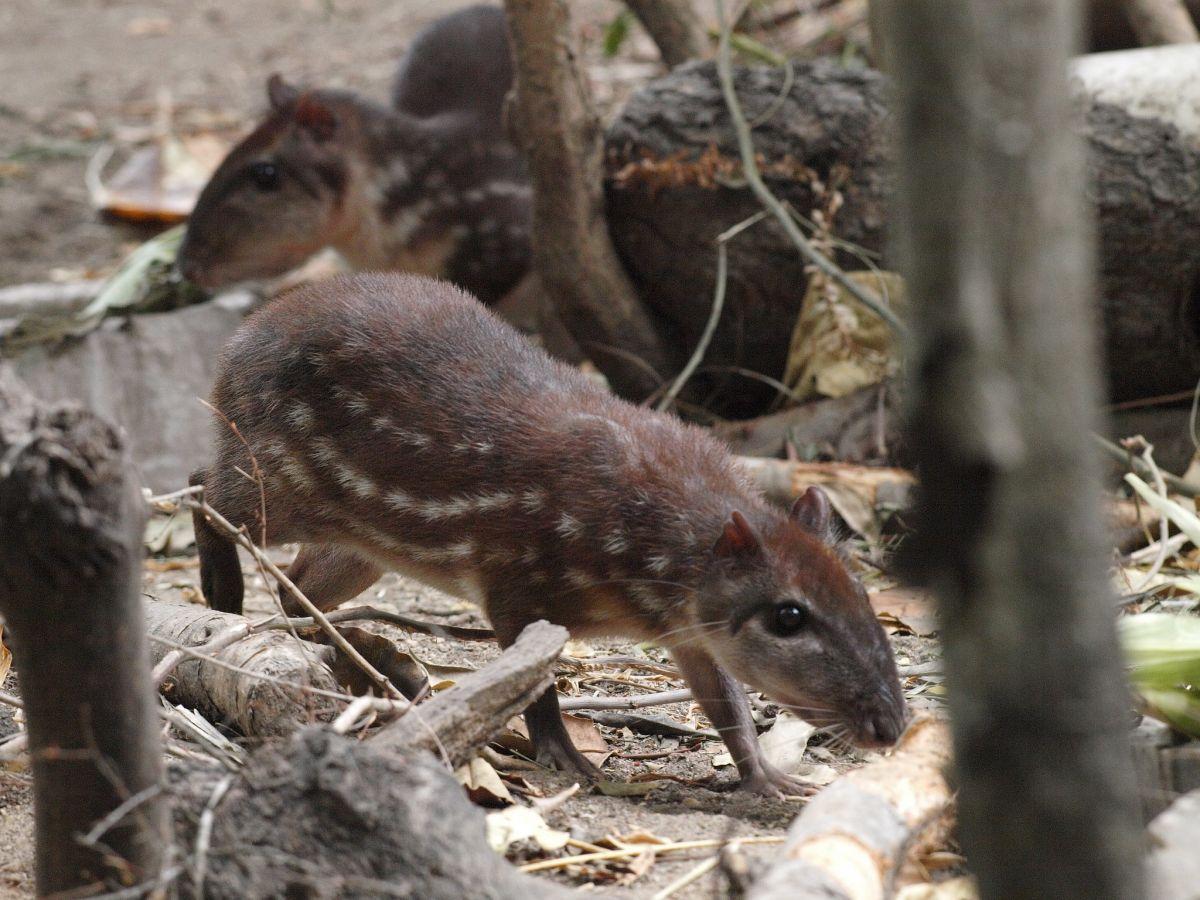
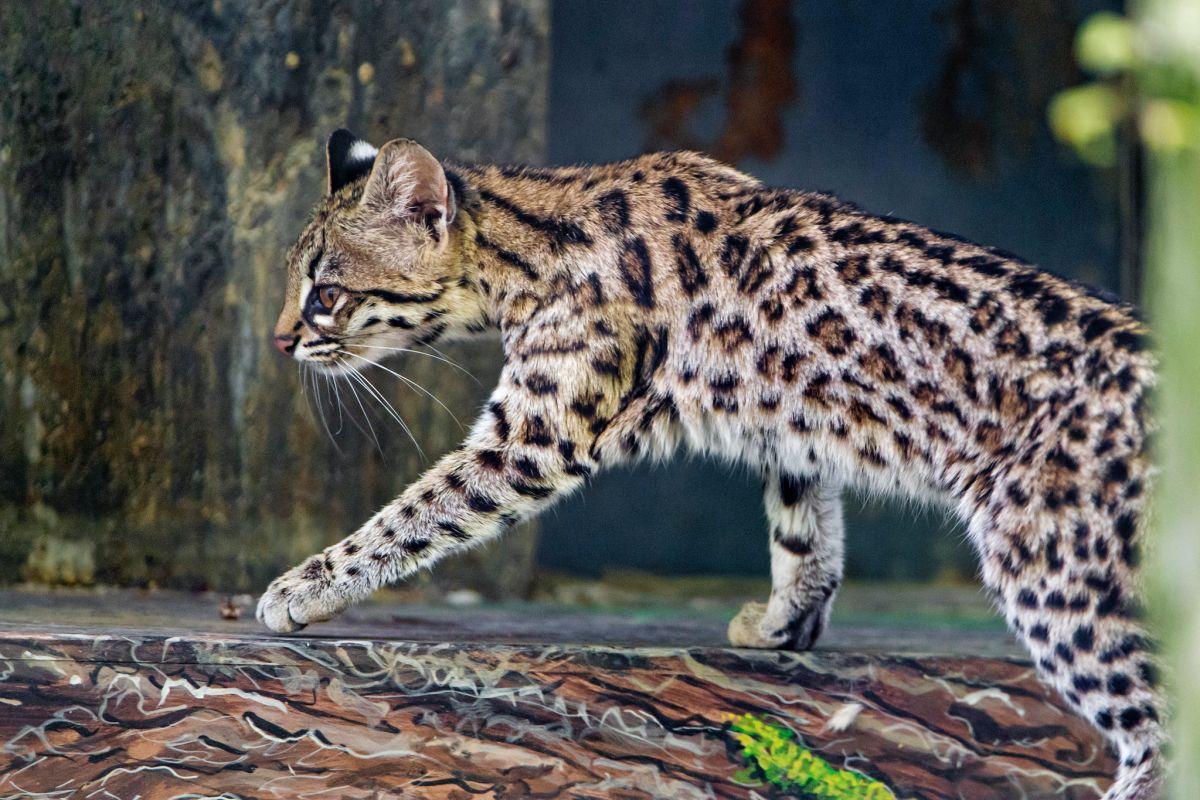

![21 Wild Animals in Bolivia [Wildlife in Bolivia]](https://www.kevmrc.com/wp-content/uploads/2022/06/21-wild-animals-in-bolivia.jpg)
![18 Wild Animals in Thailand [Wildlife in Thailand]](https://www.kevmrc.com/wp-content/uploads/2022/12/18-wild-animals-in-thailand.jpg)
![12 Wild Animals in Nigeria [Wildlife in Nigeria]](https://www.kevmrc.com/wp-content/uploads/2022/12/12-wild-animals-in-nigeria.jpg)